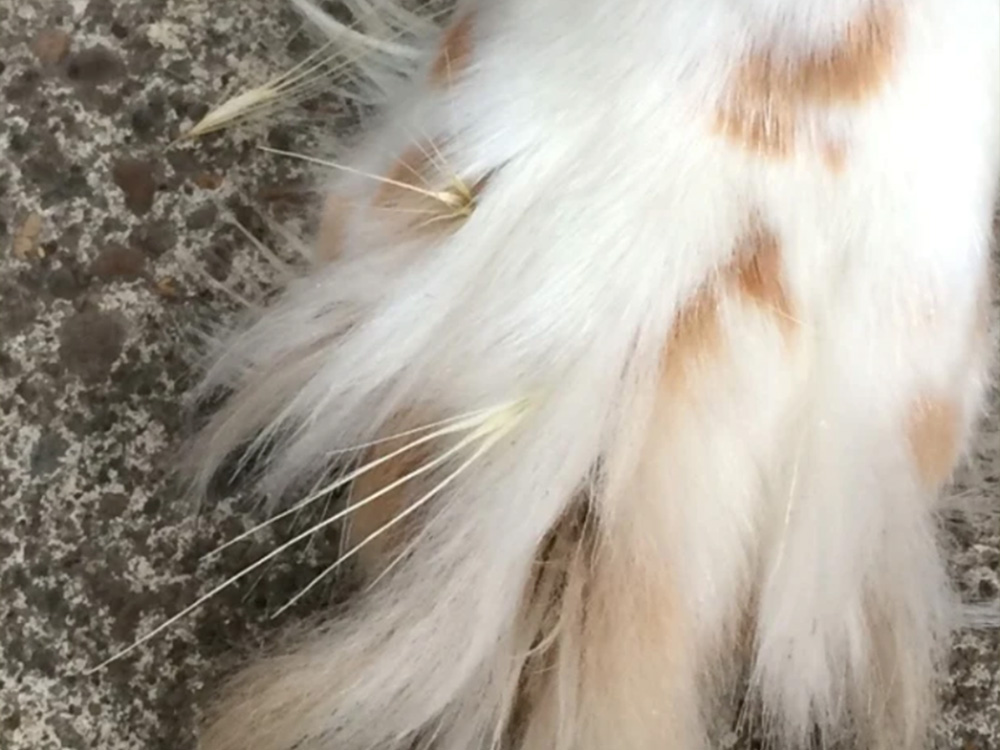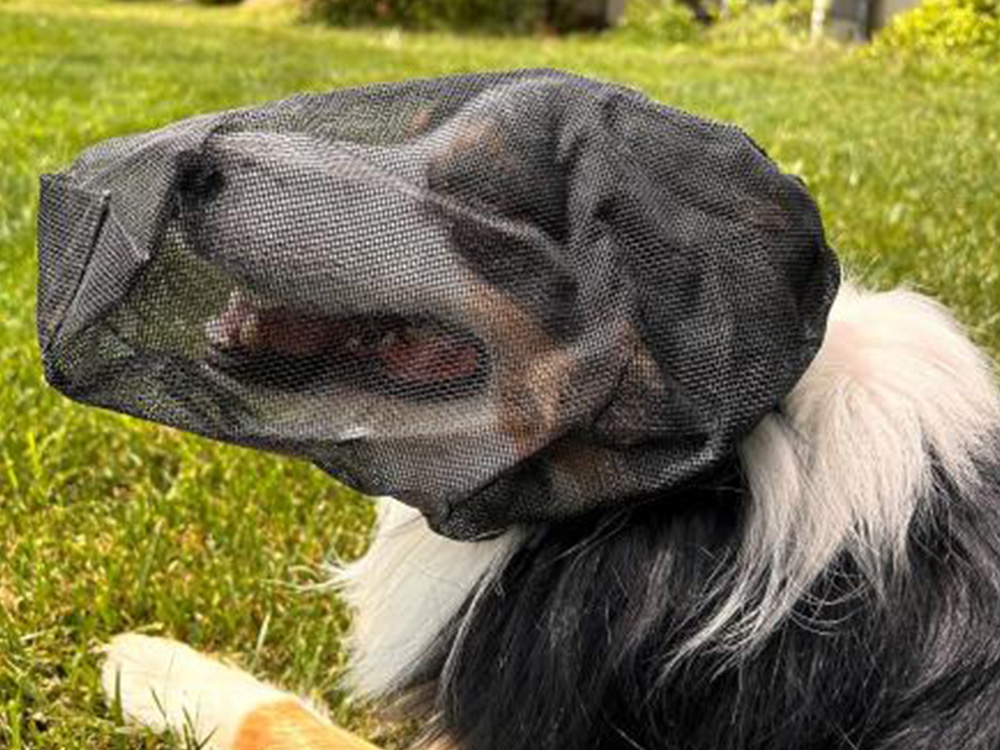Understanding the Dangers of Foxtails for Dogs in South Orange County and How to Keep Pets Safe
Key Takeaways
What Are Foxtail Foreign Bodies?
Foxtails are spiked seed clusters from specific grasses and weeds, commonly found in Southern California. These seeds, also called foxtail foreign bodies, can attach to a pet’s fur and penetrate the skin, causing abscesses, infections, and sometimes even migrating internally to vital organs. Once a foxtail has entered a pet’s body, it cannot reverse direction, meaning it will continue to burrow deeper, potentially causing serious harm.
Foxtails, shaped to burrow into the soil, are barbed, allowing them to only move forward. This characteristic makes them hazardous for pets since they can lodge into tissues, creating painful wounds and often causing infections. In Southern California, foxtail exposure is prevalent in places like hiking trails, fields, and even backyards, so pet owners should be cautious during foxtail season.

Figure 1: Foxtail grass in a green field, showing the characteristic barbed seed heads that pose risks to pets, especially during dry seasons in California.
Why Are Foxtails Dangerous for Pets, Especially Dogs?
Foxtails are a particular concern for dogs because their lifestyle often involves outdoor play in areas where foxtail grass grows. The shape and barbs on foxtails enable them to lodge into a dog’s skin or orifices, such as the nose, ears, and paws, causing injuries, infections, and sometimes serious internal damage.
Specific risks include:
For dog owners in South Orange County, where foxtail grasses grow extensively, understanding these dangers and taking preventative measures is essential.
How Do You Know If Your Dog Has a Foxtail?
Early recognition is key to preventing severe complications from foxtail exposure. Common symptoms include excessive sneezing, head shaking, paw licking, and localized swelling or redness. If a foxtail has entered the nasal passages, your dog may sneeze persistently, while a foxtail in the paw can cause limping or licking.
Signs to watch for:
Regularly inspecting your dog after outdoor activities can help detect foxtails early and prevent further health issues.

Figure 2: Foxtail seed lodged in a dog’s paw, a common site for foxtail injuries that can lead to pain and infection if not promptly removed. Source: campcocker.com/foxtails
What Are the Clinical Signs of Foxtail Foreign Bodies?
Clinical signs of foxtail injuries vary depending on the area affected. Foxtails in the nose or mouth often cause sneezing, gagging, or nasal discharge, while foxtails in the ear may result in head shaking or tilting. When foxtails embed in the skin, redness, swelling, and sometimes abscesses are common.
Clinical signs include
Note: If you observe these signs, contact your veterinarian immediately. Foxtails can migrate further, increasing the risk of infection and requiring more invasive treatments if not removed promptly.
How Do You Get Rid of Foxtails on a Dog?
If you spot a foxtail close to the skin’s surface, carefully remove it with tweezers. However, if the foxtail is embedded or causing noticeable discomfort, it’s best to see a veterinarian for safe removal. Attempting to remove deeply embedded foxtails on your own can increase infection risk and worsen the injury.
Removal tips
Veterinarians have specialized tools and techniques to remove foxtails safely and may prescribe antibiotics if there’s an infection.
How to Prevent Foxtails in Pets?
Prevention is the best defense against foxtail injuries. During the dry months in Southern California, avoid taking your dog to areas with dense grasses or fields where foxtails grow. After outdoor activities, check common areas like paws, ears, and nose for foxtails.
Prevention strategies
Bliss Animal Hospital recommends regular grooming, particularly in the warmer months, to reduce the likelihood of foxtail injuries.

Figure 3: A dog wearing a protective face mask to shield against foxtail seeds, preventing entry into the nose, eyes, and mouth during outdoor activities. Source: UC Davis School of Veterinary Medicine.
How Are Foxtail Foreign Bodies Treated?
The treatment for foxtail injuries involves removal by a veterinarian, especially when the foxtail is embedded deeply. If the foxtail has already caused an infection, your vet may prescribe antibiotics or anti-inflammatory medication. In cases where foxtails migrate internally, surgical intervention may be required.
Treatment steps include
Early intervention is ideal, as foxtails become more dangerous the deeper they migrate into a pet’s body. Monitoring your pet’s behavior and seeking prompt care can prevent serious complications.
Protecting Your Dog from Foxtails in South Orange County
Foxtail grasses pose a substantial risk to dogs and other pets in Southern California, particularly during the dry summer months. These barbed seeds can cause painful infections, abscesses, and even internal damage if they migrate deeply into a pet’s body. Knowing the symptoms of foxtail injuries and practicing prevention measures, such as avoiding foxtail-prone areas and regular grooming, can help protect your furry companion.
At Bliss Animal Hospital, our team is experienced in diagnosing and treating foxtail-related injuries. We encourage pet owners in South Orange County to be vigilant during foxtail season and reach out for veterinary assistance at the first sign of discomfort.
If you believe your dog or cat has issues related to foxtail exposure, please contact Bliss Animal Hospital at (949) 354-5201. Our veterinary team is here to help ensure your pet’s safety and well-being.
Conclusion:
Heart murmurs in dogs can range from benign to serious conditions requiring ongoing treatment. Understanding the causes, symptoms, stages, and treatment options is crucial for managing your dog’s heart health and improving their quality of life.
If you believe your dog has issues related to heart murmurs, please contact Bliss Animal Hospital at (949) 354-5201.
About Bliss Animal Hospital
Our team, led by Dr. Nayara Pataro and Dr. Sam Amirshahi, is dedicated to providing compassionate, top-rated care right here in South Orange County. With a strong emphasis on relationships and personalized veterinary care, we’re here to support you and your pet’s health and happiness. If you’re looking for convenient, high-quality care nearby, check out our veterinarian services in Lake Forest, CA and surrounding areas like Veterinarian near Mission Viejo, CA, Irvine, CA Veterinarian (Great Park and Portola Springs) and vet near Rancho Santa Margarita, CA.








Leave A Comment